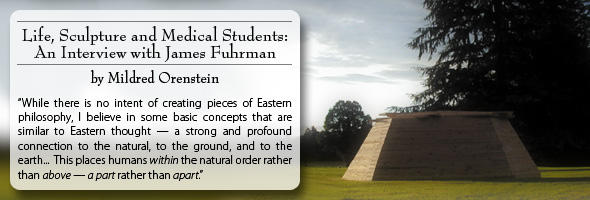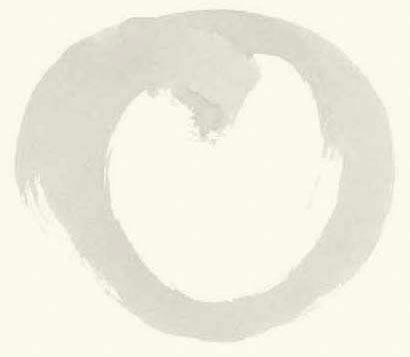
Interview of James Fuhrman by Mildred Orenstein for The Journal of the College of Arts & Sciences at Drexel University, ASK, the on-line magazine of Drexel University.
Mildred Orenstein is Director of the Drexel Writing Center, housed within the Department of English and Philosophy.
MO. I first saw some of Jay Fuhrman's sculpture several years ago and
was impressed with its expressive power. Let's begin with some general information
about you and your work as a sculptor. How long have you been a professional
sculptor?
JF. I first encountered sculpture as a student at the University of
Pennsylvania in 1963. And that, with a few side trips into education-teaching
young children-has been all that I have done.
MO. Are there
special materials you like to work with?
JF. It's interesting that you should begin with a question of materials
as that is what sculptors do. For me, the materials question is, 'How can
an idea be best expressed with my palette of materials.'
Just now I am working in wood for large temporary installation projects that need to go through small doors; wood is good because it can be lighter in weight and demountable. I would like have the pieces in a more permanent outdoor material. But one of the benefits here has been to explore the wood textures its possibilities. There is so much of a warmth and ancientness and sense of connection to the earth from it. The challenge to work in 'light weight' has taught me a new seeing.
The welded steel pieces
have a flowing lava-like melting of the material from the torch-cut surfaces
and the layering of the welding; this brings out a wonderful earth formed
irregularity of texture---rock and geologic forms. One person wrote, "Jay,
you are an alchemist: You change things into nature and nature into things."
MO. Do you prefer working in large architectural or small scale?
JF. Each one is different. Even the small pieces are monumental in
sensibility…I can do more of them and work on subtleties of relationships
in the forms. The larger ones are generally an execution of an idea first
seen smaller or conceived to be large but built as a maquette or study first.
MO. Can you tell
us something about your process as a sculptor? How do you begin? Do you start
with an idea or a feeling? Do you start with sketching or drawing?
JF. The greatest part of the development work is a dialogue between
the materials and the ideas. To me, artists are philosophers…..working
with and exploring ideas. Artists lead viewers to consider ideas. Art is an
inquiry into the nature of things:
What they look like;
What makes them look like that;
What is the interaction and relationship of the elements that
elicit responses
How 'what they look like' touches a viewer's inner self-how
they effect the affect.
Most often the work begins with an idea taken from my experience or a specific encounter or reading; I seem to find a way to give visual expression-concrete happening-to the abstract concept, push it into something new and different. Then a new iconography or story or idea evolves (sometimes in the flash of a second). Additional pieces become more views of the new idea; each variation is a meditation on that idea.
Sometimes I explore shapes by putting them together in new ways. The resultant new forms lead me to think and consider new concepts. This process is similar to what has been written about Robert Motherwell's Elegies that 'form precedes iconography'. This is an inquiry for me as an act of self-discovery as well. So I take this path of discovery…to find new ideas and relationships.
For this fall, it turns
out that most of the new work for the three exhibitions and installations
are adaptations from a basic idea, still and quiet, contemplative spaces,
and a single visual form-an enso (Zen Japanese calligraphic circle)
drawing that I did 10 years ago. Yet each is quite different because of their
materials, size and color.
MO. Is there a continuity of motif or theme in your work?
JF. The work has changed and evolved greatly over 40 years from geometric
forms standing alone in the landscape to the idea of making spaces for people
to enter (no matter the scale from eight inches to 40 feet. It surprises me
to find similar forms from the earliest works to the present-for instance,
many of the pieces have a sort of top drawn across the upper part of the piece
containing it within a space-connecting it to the ground. The work shows an
intense interest in the texture of the cut and welded steel. The circle form
has been recurring since the early1980s.
MO. Your sculpture resonates with a reconciliation of opposites: mass
with open space; power with repose; powerful presence with silence. It concerns
the connection between philosophy and art. I'm wondering here about your interest
in Eastern philosophy: Can you tell us something about that?
JF. To me your question is most flattering and I am humbled a bit by
it. I feel that the work is an expression of myself. While there is no intent
of creating pieces of Eastern philosophy, I believe in some basic concepts
that are similar to Eastern thought--a strong and profound connection to the
natural …to the ground... and to the earth … to the changing seasons…
to a geologic sense of deep time…all of which put humans as one element
of the earth rather than as the principle all-powerful controllers of the
earth. This places humans within the natural order rather than above--a part
rather than apart. These ideas have been expressed in the forms of the sculptures
and in our house design.
MO. How would you describe yourself as a sculptor? For example, would
people see your sculpture as conceptual or representational?
JF. I am surely not a representational, figure making artist. If anything
I come from the strain of Abstract Expressionist ideas of finding the source
of a sense and expressing it in the most meaningful and universal way. That
same thought has been used to describe Robert Motherwell's adaptation of the
Symbolist poet Stéphane Mallarmé's belief that a poem should
not represent some specific entity, idea, or event, but rather the emotive
effect that it produces --a search for universal content that stems from form
itself.
MO. I suppose you like working in your glass studio in the woods.
JF. Working in this almost outdoor environment has deeply enhanced
my sense of natural time …of changes - diurnal and seasonal--has connected
me to the earth in a deep and meaningful way…and to the animals…
from the chipmunks running through my legs to the smallest insects. I like
weeding although it is ever so boring; it brings me right into the ground.
I like seeing small.
MO. So many of your sculptures are titled with small haiku-like poems.
How does your writing fit into your sculpture?
JF. These poems emerged on their own. I don't know what started them.
But what I found was that they were a parallel universe to the sculpture.
They seemed to be yet another-a verbal- form of representing a sense of closeness
to the land-- a daily connection to the land with its varying weather and
seasonal changes.
MO. I understand you also teach sculpture to college students. I'm
curious; is teaching sculpture helpful to you as a creative artist?
JF. Yes, although my teaching was more design oriented. Working with
students helped me to clearly define and express the visual concepts and ideas
of art and design which are deeply part of the work.
MO. I'm thinking here of your projected interaction with Drexel medical
students. Why are you interested in this project? What do you think that interaction
will yield or lead to-for the students and for you?
JF. There
will be two overarching themes: All art tells a story; and, you have to look
closely and carefully to see that story. These two ideas are directly applicable
in the world of analysis of the medical students. But the important idea is
for the medical students, and anyone, to see that there is a visual world
filled with 'ideas' and 'stories'-about being human and that this visual world
is accessible to them.
The talk will begin by looking at some familiar symbols in contemporary product
design (Nike and FedEx) and then look at how some familiar art history ideas
(Mona Lisa) express the values of the culture and time that they were made.
The presentation will conclude by looking at a few of my own recent sculptures,
most notably the Suffering Passes, Having Suffered Never Passes work which
addresses the wrenching sense of sudden emptiness felt by people who have
suffered loss from political conflict and other catastrophes. More than to
address the often romanticized lives of the people who have died, it considers
the people who remain.
MO. I understand
one of your new works will soon be on special exhibition at the Borowsky Gallery,
at the Gershman Y, University of the Arts. Can you tell us something about
that work and the dates of the exhibition?
JF. The exhibition will be an installation that hopefully, presents
the sum of the ideas we have discussed. It will be a contemplative space of
still and quiet. There will be a principle sculpture at one end of the gallery,
a wall drawing on the opposite side with a central bench between them. The
sculpture has two circular forms-one 8x9x2' and one quite small -connected
at a tangent point-mutually supporting one another. The sculpture is made
from cedar with a burned surface which will emphasize the textural qualities
of the wood. The entire installation will be in a dark red slate colored room
that will enable viewers to see the many nuances of the burned wood finish.
On the opposite wall there is a painted wood piece, 7' square.
It will run from November 15 to January 15 at the Gershman Y, Broad and Pine Streets in Philadelphia.
At almost the same time,
there will be another Contemplative Spaces installation at Rosemont College
(November 1-29)- also with a large sculpture and wall piece.
MO.
I know our readers would love to see your sculpture and that you do have pieces
in the Philadelphia area, as well as in more distant places. But can you tell
us where we might go to enjoy seeing your work in the Philadelphia area?
JF. Just now, the best is to come to the exhibitions or see works on
line at www.jfuhrman.com. I would like if the viewers would come to the galleries
and let me know what they think.
MO. Thank you, Jay, for telling us about your sculpture and for sharing your
ideas about creativity and the hard work behind it.
JF. Thank you for asking. The interview has given me yet another opportunity
to clarify my own experience of the work.

